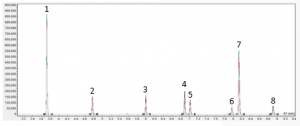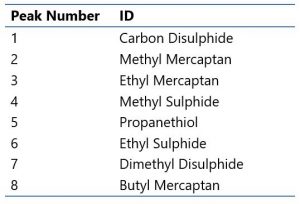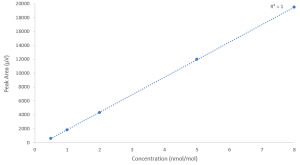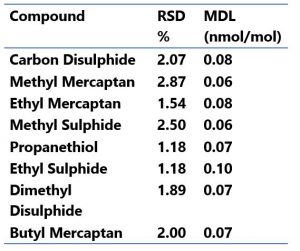Environmental Monitoring of Low-Level Sulphur in Ambient Air
Introduction
Ambient Air Quality Monitoring of Sulphur Compounds
The presence of sulphides in ambient air is an environmental hazard. The detection of sulphur compounds at trace levels is critically important through ambient air quality monitoring. Monitoring sulphur compounds is commonly done in industrial emissions testing and environmental monitoring at sewage treatment and landfill sites. Compounds such as carbon disulphide, methyl mercaptan, ethyl mercaptan, dimethyl sulphide, propanethiol, ethyl sulphide, dimethyl disulphide and butyl mercaptan are volatile compounds that require thermal desorption as a means of analysis.
Thermal desorption is a technique that provides a trace level analysis through both offline and real time monitoring of vapour changes in the sampling environment.
This application note describes environmental monitoring of low level sulphurs in ambient air through thermal desorption gas chromatography.
Experimental
A Scion 456 GC with a pulsed flame photometric detector (PFPD) was using in combination with thermal desorption. Ambient air samples were collected using a low temperature on-line sulphur monitoring system. The pre-concentration unit was cryogenically cooled and enriched with samples thermally analysed. Analytical conditions for thermal desorption can be found in Table 1a with the GC-PFPD parameters in Table 1b.
Table 1a. Analytical conditions of the thermal desorption

Table 1b. Analytical conditions of the GC-FID

An ambient air gas standard was diluted to 0.5, 1.0, 2.0, 5.0 and 8.0nmol/mol using a stainless steel ultra-clean valve. The gas standard included the following target compounds carbon disulphide, methyl mercaptan, ethyl mercaptan, dimethyl sulphide, propanethiol, ethyl sulphide, dimethyl disulphide and butyl mercaptan.
Results
Figure 1 shows the 5.0nmol/mol gas standard during repeatability testing. The 5.0nmol/mol standard was analysed with eight consecutive injections. Due to excellent sensitivity to sulphide by the PFPD, the response for carbon disulphide and dimethyl disulphide is much greater than the other target compounds. Identification of corresponding target analytes can be found in Table 2.
Figure 1. 5nmol/mol gas standard of ambient air components

Table 2. Peak identification of components in Figure 1.

Excellent linearity was observed for all target compounds in the gas standards. The average correlation coefficient was 0.9999 with each compound achieving an R2 value of 1 with the exception of methyl mercaptan and dimethyl disulphide which had an R2 value of 0.9999. Figure 2 shows the calibration curve of carbon disulphide and is representative of all target compounds.

Repeatability was demonstrated with eight replicates of the 0.5nmol/mol standard. Table 3 details the RSD% value as well as the calculated method detection limit (MDL) for each target compound.
Table 3. Repeatability values and method detection limits (n=8)

The eight target compounds show excellent repeatability at the lowest concentration analysed of 0.5nmol/mol. Additionally, exceptionally low detection limits were obtained for each target compound. These results highlight the sensitivity and robustness of the system.
Conclusion
The Scion GC:PFPD analyser for the ambient air quality monitoring of low level sulphurs is the ideal solution for all environmental monitoring requirements. In under 15 minutes, including sample preparation and sample analysis, eight target compounds were easily separated and resolved with excellent repeatability and low detection limits.
Download Application Note
Download the complete Application Note: Environmental Monitoring of Low-Level Sulphur in Ambient Air
Gas Chromatography Solutions for Ambient Air Quality Monitoring
A SCION Gas Chromatography Analyser was used to conduct this research. Providing excellent solutions for Environmental, Oil and Gas and Chemical industries, find out more about Scion GC Analysers.
If you would like to find out more, simply contact a member of our team. We look forward to hearing from you.
To be the first to hear about future research articles from SCION Instruments, be sure to join us on social media and sign up to our eNewsletter via the links below.
